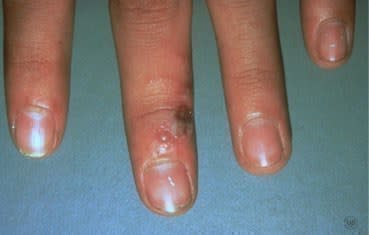Herpes simplex: Signs and symptoms
Many people who get the virus that causes herpes never see or feel anything. If signs (what you see) or symptoms (what you feel) occur, a person may experience:
Tingling, itching, or burning. Before the blisters appear, the skin may tingle, itch, or burn for a day or so.
Sores. One or more painful, fluid-filled blisters may appear. Blisters break open and often ooze fluid and form a crust, before healing. The first time sores appear, they will show up between 2 and 20 days after a person has contact with an infected person. The sores can last from 7 to 10 days. Where the sores appear often varies with type:
If a person has HSV-1, a bad sunburn can trigger a herpes simplex outbreak.

Flu-like symptoms. Fever, muscle aches, or swollen lymph nodes (glands) in the neck (oral herpes) or groin (genital herpes) are possible.
Problems urinating. People (most often women) with genital herpes may have trouble urinating or have a burning feeling while urinating.
An eye infection (herpes keratitis). Sometimes the herpes simplex virus can spread to one or both eyes. If this happens, you can have pain, light sensitivity, discharge, and a gritty feeling in the eye. Without prompt treatment, scarring of the eye may result. Scarring can lead to cloudy vision and even loss of vision.
If you develop signs and symptoms of herpes simplex, you can expect to have these for as long as listed below:
Oral (mouth) herpes: two to three weeks
Genital herpes: two to six weeks (the first outbreak)
Herpes simplex outbreaks usually develop around the mouth or on the genitals, but the sores can appear almost anywhere on the skin.

Images
 Atopic dermatitis: More FDA-approved treatments
Atopic dermatitis: More FDA-approved treatments
 Biosimilars: 14 FAQs
Biosimilars: 14 FAQs
 How to trim your nails
How to trim your nails
 Relieve uncontrollably itchy skin
Relieve uncontrollably itchy skin
 Fade dark spots
Fade dark spots
 Untreatable razor bumps or acne?
Untreatable razor bumps or acne?
 Tattoo removal
Tattoo removal
 Scar treatment
Scar treatment
 Free materials to help raise skin cancer awareness
Free materials to help raise skin cancer awareness
 Dermatologist-approved lesson plans, activities you can use
Dermatologist-approved lesson plans, activities you can use
 Find a Dermatologist
Find a Dermatologist
 What is a dermatologist?
What is a dermatologist?